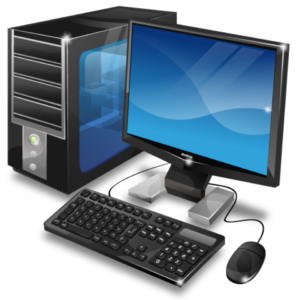repair
Why Does My Computer Get Hot?
A common issue that many computers suffer from is overheating. As mobile computers are getting slimmer, there is less room for cooling fans or even just air to circulate. With desktop computers, more powerful processors and huge video cards are generating more heat inside the cases. In this article we will explain just why your computer overheats, and outline ways to combat it!

The Shrinking Laptop
In our previous post “The Desktop PC – Still Relevant?”, we touched on how the industry is trending more mobile, and the sizes of the devices we use are changing. Laptops are cheaper than they’ve ever been. They are thinner and lighter than ever, and they are much more powerful than they were even a few years ago. With that being said, we’d like to delve into a few minor setbacks to the cheaper, thinner, lighter laptops of today.
The Desktop PC – Still Relevant?
As the technological world of computers skews more and more toward mobile, and everything is getting smaller and smaller, the questions arises – is the desktop PC still relevant? The short answer is a resounding YES. In this article we will elaborate as to why.

Even though more and more people are moving from the desktop to their laptops, or even tablets or smartphones, a traditional desktop computer is still arguably a great choice as a secondary computing device today. Some of the reasons to buy a desktop today range from cost to performance ratio, upgrade-ability, to more productivity considerations. Check out these items:
Video Technology
Computer technology seems to change over night at times. One aspect of that technology that confuses many people are the video connection standards. There’s a few of them and they are constantly evolving. In this post we hope to clear up a little of that confusion.
The History
Let’s go back to the beginning of consumer computing, and explore how it’s evolved from there.
CGA (Color Graphics Adapter) – First available on the IBM PC in 1981 as IBMs first color display card, thus the first color display standard. It only used 16 kilobytes of memory and displayed at 640×200 @ 60mHz 4-bit or 16 colors. It connected using a DE-9 (9-pin) connector.
EGA (Enhanced Graphics Adapter) – The next leap in display standard evolution. Introduced in 1984 by IBM, it displayed at 640×350 @ 60mHz & 16 colors. This graphics card had 64KB of onboard ram. It also connected using a DE-9 connector.
VGA (Video Graphics Array) – This is the video connector that most computer users are familiar with. Introduced in 1987 by IBM with the debut of their x86 computers. Connected with a DE-15 (15-pin) connector, VGA was the last of the analog video standards to be developed. It displayed up to 2048×1536 @ 85mHz and 256 colors.
Here and Now
DVI (Digital Visual Interface) – Developed by Digital Display Working Group in 1999, this standard could be configured be configured to support multiple modes such as DVI-A (analog only), DVI-D (digital only) or DVI-I (digital and analog). Featuring support for analog connections, the DVI specification is compatible with the VGA interface. DVI has a unique horizontal connector that .varies slightly depending on the configuration. It can display 2560×1600 @ 60mHz or up to 3840×2400 @ 33mHz.
HDMI (High-Definition Multimedia Interface) – HDMI is currently gaining traction as the de facto video connection on desktops, notebooks, and even mobile devices. HDMI is a digital replacement for analog video standards. It can transport compressed, uncompressed, video and audio, and auxiliary data. Different versions of HDMI have been deployed since the initial release but all use the same cable and connector. Other than improved audio and video capacity, performance, resolution, newer versions have optional advanced features such as 3D, and Ethernet data connection. Displaying 2560×1600 @ 75mHz or 4096×2160 @ 60mHz, HDMI uses a much smaller connector than DVI.
DisplayPort – A digital display interface (designed by VESA – Video Electronics Standards Association) primarily used to connect a video source to a device such as a computer monitor, though it can also be used to carry audio, USB, and data. DisplayPort was created to replace VGA & DVI, and is backward compatible with VGA, DVI and HDMI using the appropriate adapters. It can display 2560×1600 @ 75mHz or up to 8192×4320 @ 60mHz. DisplayPort uses a 20pin connector.
Mini DisplayPort (Thunderbolt)
If you’re using an Apple computer, new systems come with Mini DisplayPort. Mini DisplayPort is the same connector as Intel Thunderbolt technology allowing that port on new Macs to do more than just video. It’s used in Apple Cinema displays and has adapters for DVI, VGA, HDMI or regular DisplayPort. Mini DisplayPort uses a small 20-pin connector seen on Apple devices and some PCs and PC graphics cards.
Your Computer
Today’s computers, both laptops and desktops typically are coming with HDMI or DisplayPort as video connection options. You can still find DVI and VGA on some models but it is quickly being phased out by the new, more powerful digital standards. Flat screen TV technology has also embraced these digital standards for connecting not only your computer but other devices to your TV.
We hope that this information has made understanding the video connection varieties a bit easier. If you have further questions about this topic or any other, feel free to email us, call us, or contact us through the website.
Geek Easy Computers wants to make your technology easier!
 |
Adonis Pointer is a photographer, a collector of vintage razors, and a certified technology geek! Adonis has been involved in computer technology since well, a LONG time! He has been involved in nearly every aspect of the industry from sales to repair to training to consulting. As the Social Media Manager he writes the majority of the posts on the Geek Easy Computers blog. |